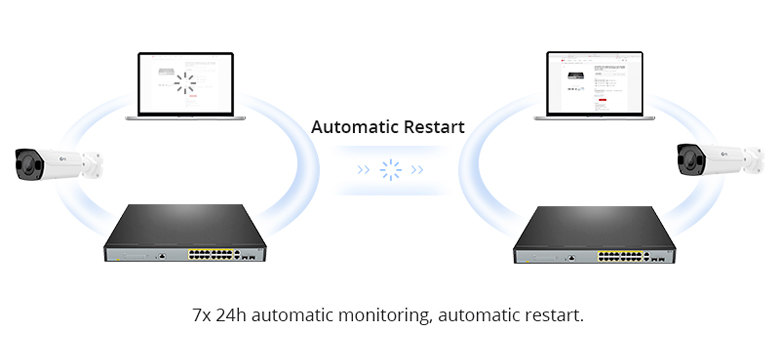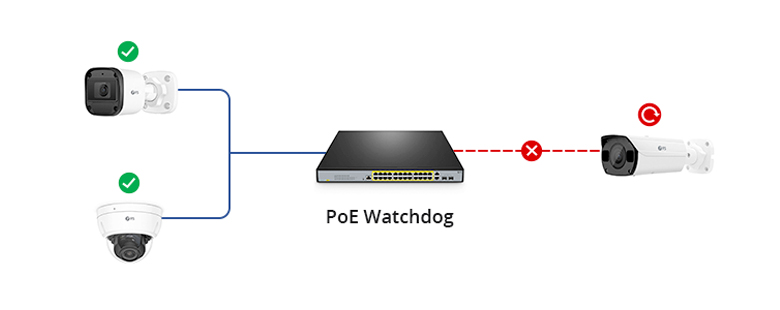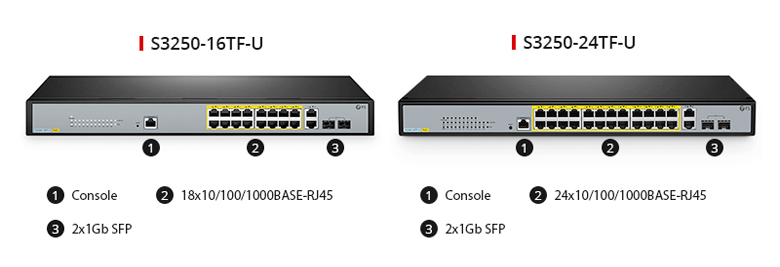In the current digital era, monitoring systems are crucial for overseeing and protecting resources and equipment. Security camera failures can lead to lost surveillance footage, potentially causing network problems. To tackle these issues, network switch manufacturers have introduced the watchdog function. It’s both a tech innovation and a vital tool for system stability.
What Is Watchdog in PoE Network?
The PoE watchdog feature on a PoE network switch serves as an automated “self-repair” mechanism, designed to oversee the condition of connected PoE-affiliated devices and furnish a solution to reboot them should they exhibit unresponsiveness or malfunctions. Should a PoE-connected device, or Powered Device (PD), fail to communicate or send inaccurate responses within a certain period, the switch shall autonomously reinstate the device by discontinuing and then reinstating power. This protocol is aimed at averting network interruptions and guaranteeing the uninterrupted functioning of attached devices.This PoE watchdog capability proves invaluable in settings where the connected devices are pivotal to network functionality, such as within surveillance frameworks. It aids in boosting network stability and dependability. Fundamentally, the watchdog capability serves as a custodian for network devices, safeguarding their unbroken operation. In scenarios where continual network service is paramount, like in monitoring systems, the watchdog feature is especially critical as it prevents service interruptions and upholds system dependability.
Why is PoE Watchdog Used?
Improving Device Reliability and Network Stability
A watchdog feature ensures the reliability of network devices, such as cameras or servers, by monitoring their status and automatically resetting them if they become unresponsive or malfunction. This proactive approach reduces the risk of prolonged downtime and helps maintain uninterrupted network service, particularly in critical environments like surveillance setups or industrial operations.
Automating Troubleshooting for Operational Efficiency
In the absence of a watchdog, IT staff may need to manually diagnose and reboot devices upon failure, consuming valuable time and effort. The automation provided by the watchdog reduces the need for continuous manual oversight, thus streamlining troubleshooting processes and conserving resources.
Enhancing System Availability and Network Performance
The implementation of a watchdog feature significantly boosts system availability by mitigating the impact of device malfunctions, ensuring continuous operation in environments where uptime is essential. Additionally, by actively monitoring and rectifying device discrepancies, the watchdog function enhances network reliability, preventing sequential failures and sustaining uniform network performance.

How PoE Watchdog Works in Security Surveillance?
Health Status Monitoring and Verification
The watchdog function periodically sends signals or queries to network cameras to confirm their proper operation, typically at intervals of a few seconds. These signals, which can be heartbeat signals or specific requests, aim to verify whether the cameras are responsive and functioning as expected.

Issue Detection and Abnormal State Identification
By setting a timeout threshold, the watchdog function determines that network cameras must respond within a specified time frame. If a camera fails to provide the correct response or does not respond within this timeframe, the watchdog function identifies it as being in an abnormal state, signaling a potential issue.
Automatic Restart Mechanism for Fault Resolution
Upon detecting an abnormal state, the watchdog function triggers an automatic restart process for the network camera. This typically involves sending a command to the camera or activating a restart switch to initiate a reboot. Following the restart attempt, the camera undergoes necessary actions such as hardware reinitialization or software rebooting to restore normal operation.
Continuous Monitoring and Stability Assurance
After a successful restart, the watchdog function continues to monitor the health status of the network camera. It ensures that all systems are functioning correctly and stable, providing ongoing monitoring to maintain the camera’s operational reliability.
PoE Watchdog-Supported Switches for Network Reliability
FS offers PoE switches with watchdog functionality, such as the S3250 series. These switches are designed to enhance network reliability and stability, ensuring that your network devices remain operational and Minimising potential downtime.

| Switch Model | S3250-16TF-U | S3250-24TF-U |
| Description | 16-Port Gigabit Ethernet L2+ PoE+ Switch, 16 x PoE+ Ports @230W, with 2 x 1GbRJ45, 2x1GbSFP Uplink | 24-Port Gigabit Ethernet L2+ PoE+ Switch, 24 x PoE+ Ports @370W, with 2 x 1GbRJ45, 2x1GbSFP Uplinks |
| RJ45 Ports | 18x 10/100/1000BASE-T RJ45 | 26x 10/100/1000BASE-T RJ45 |
| Fibre Ports | 2x 1G SFP | 2x 1G SFP |
| Switch chip | Marvell 98DX225SA1 | Marvell 98DX225SA1 |
| Switching capacity | 56 Gbps | 56 Gbps |
| Forwarding rate | 29.76 Mpps | 41.7 Mpps |
| Total Number of IPv4 Routes | 16 | 16 |
| RAM | 2 Gbit | 2 Gbit |
| Flash memory | 128 Mb | 128 Mb |
| Latency | Max: 4.28us; Min: 3.29us | Max: 4.28us; Min: 3.29us |
| Packet buffer | 12 Mbit | 12 Mbit |
| Power supply | 1 | 1 |
| Fan number | 1 | 2 |
| Airflow | Left-to-Right | Left-to-Right |
| Max. power consumption | 365W | 420W |
| PoE standard | IEEE802.3af/ IEEE802.3at/IEEE802.3bt | IEEE802.3af/ IEEE802.3at/IEEE802.3bt |
| PoE power budget | Port 1-2 ≤ 90W, Port 3-16 ≤ 30W, total ≤ 230W | Port 1-2 ≤ 90W, Port 3-24 ≤ 30W, total ≤ 370W |
Conclusion
The PoE watchdog function is an essential tool for guaranteeing network reliability and stability, playing a vital role in both network devices and security surveillance. In the constantly evolving and digitalised networking landscape, deploying switches and devices equipped with the watchdog feature has become the preferred choice for safeguarding network stability. In addition to the aforementioned distinctive technologies, FS also provides smart PoE support, fanless designs, and high-power managed PoE switches, catering to various deployment scenarios in enterprises.
Related Articles:
FS Unleashes Open Network Switches, Powering Intelligent Networks Forward
